
BB Centrum and IMAGE OF THE CITY
Pavel Nasadil
Publisher
Pavel Nasadil
16.06.2010 21:40
Pavel Nasadil
16.06.2010 21:40
Jan Aulík
Jakub Fišer
Pavel Nasadil
FAM Architekti
Aulík Fišer architekti
 |
The range of work of the Aulík Fišer studio is broad, and I contemplated the topic of the text for several days. Choosing from the projects of my favorite would come at the expense of others and surely lack objective distance. However, one project by this team stands out from the rest due to its size, time span, and greater concentration of their buildings. It catches my eye every time I drive from Prague to Brno. I decided to focus on the area colloquially known for 17 years by the street Baarova and the building Brumlovka as "BB Centrum," which I had the chance to influence personally during the time when the administrative building E (ČEZ) and the sports center Nová Brumlovka were conceived.
In my opinion, BB Centrum is the most significant contribution of both architects to the urbanism of the city, especially in the way this quarter invigorates the appearance of Prague's periphery and gives confidence to other investors to bring their investments closer to the main road. In the early stages of construction, BB Centrum appeared to the professional public as a monofunctional group of solitary administrative buildings without the attributes of natural urbanity. The impression of an administrative district detached from the surrounding periphery is gradually blurring into an image of an urban structure, supplemented by further functional layers. The ground floors of the buildings are enlivened by shops, services, and restaurants, and the spaces between the buildings are more than just mere connectors to the entrances of the offices or transportation services with parking lots. The initiated urban structure is complemented, stabilized, and is becoming more interesting. Thanks to the sports and social center, kindergarten, and a variety of commercial services, BB Centrum is no longer as monofunctional as it initially seemed. Since I have been observing its development for some time now, I am struck by questions I also hear from my architect colleagues: is BB Centrum a city? And if so, what is its image?
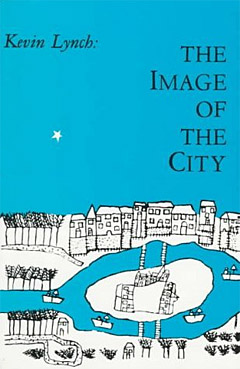 |
As a methodological guide for this experiment, I borrow the famous analysis of American urbanist, theorist, and MIT professor in Boston, Kevin Lynch: "The Image of the City," published in book form in the USA in 1960 (1). The significance of this fundamental urban study lies primarily in how Kevin Lynch analyzes the city and its form. Through questioning ordinary people, Lynch examines what the form of a particular place means to its inhabitants and how it influences the image of the city, orientation, and decision-making of individuals in space. The result of his surveys is a kind of mental maps of urban quarters, which arise from the sum of knowledge about the perception of public space by its residents. Lynch's analysis is limited solely to the physical elements of the city. The recorded image is then a compilation of individual representations of many people. Based on interviews with people, Kevin Lynch describes the image of the city through five elements:
1. Paths are routes along which the observer regularly or randomly moves. They can take the form of streets, sidewalks, transfer points of public transport, canals, and railway tracks. The other elements of the city are arranged along these paths.
2. Edges are linear elements that form boundaries between two parts of the city. They are linear pauses such as rail cuts, walls, edges of buildings, etc. They create barriers that may be permeable, yet separate one part of the city from another. For many people, edges can be important identifying features of the city or its regions.
3. Districts are medium or large parts of cities that bear characteristic signs for many observers. People identify with districts either from the perspective of being "inside" or from the perspective of "outside." Most people can structure cities into districts themselves.
4. Nodes are strategic points in the city, places to which entry is possible, from which traveling is possible, and which are focal points in the city. They primarily include intersections, public transport transfer stations, and pedestrian route crossings. They can also be places with strong characteristics, such as a prominent corner of a building or areas of concentration of human activities, shops, services, etc. Nodes often do not have a strong physical form or appearance. If they do, they are easily memorable.
5. Landmarks are points of interest that serve as external visual orientation elements. They can be buildings or natural landmarks visible from a distance. They can also be local elements visible only from a specific place, such as signs or urban details. The perception of these details is of course individual and dependent on the degree of familiarity of the person with the place.
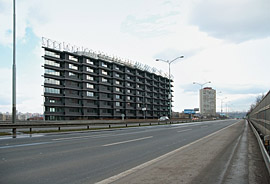 |
A large percentage of the people I spoke to did not strongly register these elements in the city or were unable to describe them. However, I was surprised that after a longer discussion and a clear formulation of questions, everyone was able to articulate their perceptions of BB Centrum quite accurately and identify Lynch's urban elements through their perspective. While Kevin Lynch conducted his surveys using three methods (office interviews, testing informed observers by walks directly in the field, and interviews with randomly approached people directly in the field), in my case the survey was conducted through interviews with randomly approached people in the interiors and exteriors of BB Centrum.
I began my Lynchian survey on Sunday, March 14, 2010, in the afternoon, in the wind and rain, at a time when it is generally believed by quickly condemning architects that BB Centrum is empty. In the surprisingly busy and crowded pizzeria in the Brumlovka building, I interviewed my first respondent - the operational manager of the restaurant. This was followed by another 34 people with whom I had the opportunity to discuss in BB Centrum over the next few weeks. I tried to generate an objective image. The discussions were not aimed at a single target group. I talked to people who worked inside the offices, visitors who randomly passed through, and also residents of surrounding residential buildings. The respondents working in BB Centrum had been employed there for an average of 2.7 years. I completed the survey on April 20.
Given the smaller number of respondents (35 compared to 160 people in Lynch's study) and the disproportionately shorter time I dedicated to my field work compared to Lynch, we can regard the results as merely indicative, without the possibility of broad generalization to the entire target group of people working in BB Centrum or living in its vicinity. Compared to the cities analyzed by Kevin Lynch (districts in Los Angeles, Boston, Jersey City), BB Centrum is a very small quarter, which is still developing, completing, and changing. Its "image" will likely reflect the time of writing this text, and the depicted map may look entirely different in ten years. The five urban signs listed below should be considered only as empirical categories around which a certain amount of information has been collected.
If this information and the method of obtaining it prove useful, they may further serve architects as a means to reflect on the urbanism of the city.
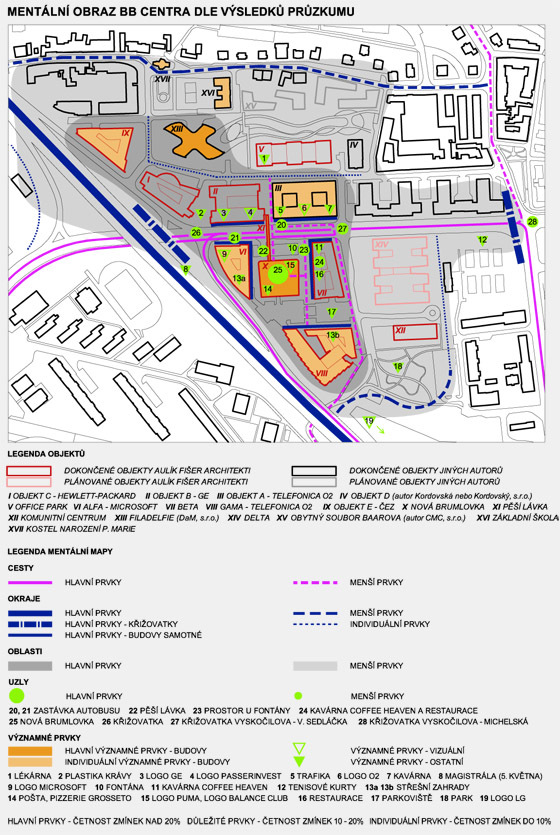 |
Paths
 |
Edges
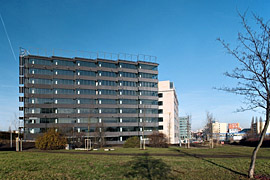 |
Districts
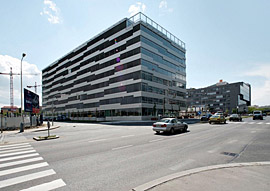 |
Nodes
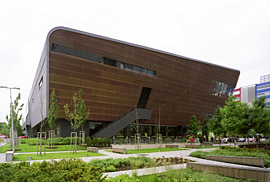 |
Landmarks
 |
Further significant elements in the entire quarter are considered to be the logos of companies placed on individual buildings. They are a characteristic feature of BB Centrum. The most frequently mentioned is the O2 logo and the inscription "PasserInvest" on building B, which is also visible from the interiors of Nová Brumlovka (e.g., from the pool). The receptionist of the fitness center is so fascinated by it that she can draw it from memory. Another prominent logo is Microsoft on the ring road side, the PUMA logo on the northeastern edge of Brumlovka, the inscription Balance Club visible when exiting the highway, or the logo of the vegetarian restaurant Maranatha visible when getting off the bus at the Alfa building.
The pedestrian bridge over Vyskočilova Street is considered an important element, not for its architecture but for the large electronic clock placed on it, measuring the time, date, and temperature. Regarding the pedestrian bridge, the number of advertisements placed on it, the narrow profile of its access stairs, and the view of the pharmacy in the Office Park building were mentioned. Two questioned young ladies mentioned an experience where one can regularly see into the hall of Nová Brumlovka from the windows of the bus and observe, for example, exercising athletes or activity in the hairdressing salon.
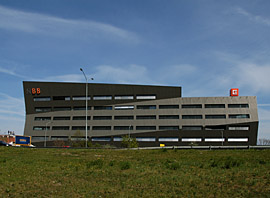 |
Several respondents pointed out the presence of trees along Vyskočilova Street and the imaginative planting of shaped shrubs directly under the inclined façade of Brumlovka. The landscaping was mentioned by 31.4% of respondents in total and seems to be a very important urban commodity, especially for those who move around the city on foot. For the employees of the office buildings, the accessibility of the terraces and especially the rooftop gardens, which are on most buildings and allow for a short break with coffee, a book, or lunch, was a fundamental advantage. For employees, the accessibility of these green roofs is a great phenomenon from the perspective of better work commitment.
Last but not least, nearly all people could without hesitation point in the correct direction to the center of Prague. As a guide, they mostly mentioned the ring road or the Budějovická metro station; that is, rather the direction in which they will travel to the center. Only one observer mentioned the broadcasting tower in Žižkov, visible from the buildings on the northern side of Vyskočilova Street.
What is the mental image of BB Centrum?
I did not reach any definitive conclusion, and it can be argued that the result of the survey is speculative and irresponsible. The city is neither beautiful nor magnificent. According to Kevin Lynch, such a city cannot exist. The image of the city, according to him, arises from the interactive stimulation between the environment and its observer. Lynch uses the term "Imageability" in connection with the expressions Image (obraz) and Ability (schopnost). According to him, a city has the ability to evoke mental images in people, and a good city has a higher potential for this than a bad city. Shape, color, arrangement - all these create a mental image of the environment and thus the identity of the place as perceived by people. The urban environment contains various differences and links, which the observer selects based on their personal interests and abilities and assigns meanings to them. A strong image in the city can be created by any inconsistency, exception in the construction, pause, or uniqueness. Simplistically, one might talk about the "visibility of the city."
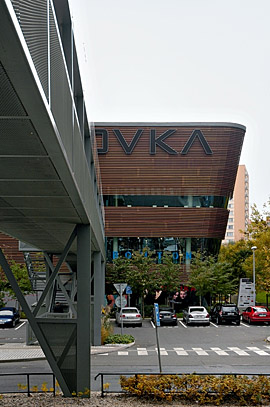 |
Every city has its nice and worse places, and so it is with a small urban fragment such as BB Centrum. The predominantly positive impression from it is certainly interesting in comparison to how an ordinary person - a resident of Prague - perceives their everyday living space. They notice disorder, problems, chaos, dirt, and traffic situations. In the case of BB Centrum, however, the experience is the opposite. Positive mentions prevail in the listings, rather than complaints. The area is easy to navigate, thanks to its small size, the orientation of the buildings towards the main street, the specific architecture of the structures, and not least the numerous logos and signs. The public image of BB Centrum, which most people perceive, is that of an administrative-commercial place with high-quality facilities. The image of the entrance is associated with intersections, crossings, exits, and entries from the ring road. The image of the Path is associated with the layout of public transport, bus stops, the pedestrian bridge, and the underpass beneath the ring road. The image of the Edge is evoked by the ring road, intersections of streets, building facades, Baarova Street, or the park. The image of the District in this case relates to the form and function of the place, modernity and height of the buildings, glazed facades, large windows, and also the cultivated ground floor. The ability to outline an image according to the significant elements is greater among people who have been working in BB Centrum for a longer time (e.g., 9 years - parking lot guard) and among foreigners (American lecturer, Berliner), who form their mental image from the position of visitors, thus from the outset with increased interest. For these "perceptive" individuals, insights and perceptions are intertwined in a domino effect, where one stimulus reminds one of another, which triggers another stimulus or memory, etc. The weakest perception is clearly from car drivers.
The most important element is the aforementioned Nová Brumlovka building and its programmatic offering. Thanks to it, it can be said that the mental image of BB Centrum has a distinctly central form that weakens towards its periphery (see image). The part of the city that probably has stronger visual stimulation (e.g., Old Town Prague) places much greater emphasis on the attention and involvement of the observer. It will likely have a polycentric image, much more complicated and granular. The image of the periphery is inherently weaker than the image of the historical center of the city.
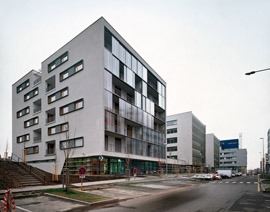 |
I believe that in the case of BB Centrum, it is possible to further "create the image of the city," as it still does not have a definitive image. It is possible to add further layers and build new spatial connections, refining its definitions. The least readable and still unfinished areas, such as the northern, eastern, and southwestern zones of BB Centrum, are still waiting for their form and building development. If a layer of public spaces with rich imaginative potential is tied to them, along with the inclusion of residential functions, a successful urban organism will emerge. Together with the broader urban structure of Michle and the metropolitan structure of Prague, to which BB Centrum is connected in both transportation and spatial terms, we will soon be able to talk about the natural integration of BB Centrum into the city as a whole.
It is undeniable that the team of the architectural studio Aulík Fišer had, has, and will have a fundamental influence on this image of the city.
Pavel Nasadil
In Prague in April 2010
(1) The Image of the City: Kevin Lynch - published in 1960 by the Massachusetts Institute of Technology and the President and Fellows of Harvard College
The English translation is powered by AI tool. Switch to Czech to view the original text source.
0 comments
add comment











